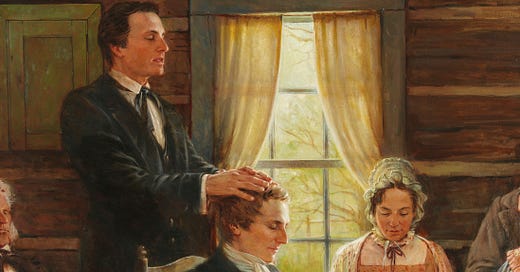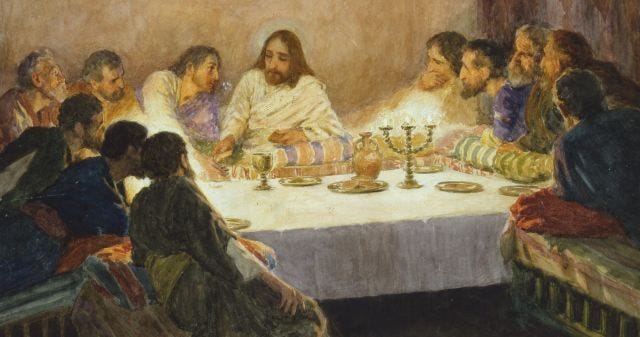Everything that we have studied in the Doctrine and Covenants and in LDS Church history thus far crescendos toward the restoration of the Church of Jesus Christ of Latter-day Saints. After centuries of religious confusion, conflicts between Catholics and Protestants, a proliferation of sects and denominations, and competing religious dogmas, it was time for the earth to stand still and for its inhabitants to bow in reverent awe as the Lord Himself revealed the true order and principles of His Church.
The Come Follow Me manual of the Church of Jesus Christ of Latter-day Saints encourages members to consider why we have an organized Church, and to highlight similarities between the Savior’s Church in ancient times and the restored Church today. While this is an enlightening exercise, I believe that a further distinction must be made between the Church that Jesus Christ restored through the Prophet Joseph Smith and the sprawling multi-billion dollar corporation that has appropriated the name of the Lord’s Church in modern times.
Recent events have begun to lay bare the glaring discrepancies between the Church that Jesus Christ restored through the Prophet Smith and that which we now call the Church of Jesus Christ of Latter-day Saints. There are still enough similarities between the two churches to satisfy many complacent modern “Mormons,“ but the scales are have begun to fall from the eyes of a growing constituency of faithful saints.
Before delving into the distinctions between the Church that the Lord restored through the Prophet Joseph Smith and the modern LDS, Inc., it behooves us to highlight the similarities between the Lord’s Church in the meridian of time and His Church as outlined in D&C 20.
For example, the Lord called Peter to lead His original Church and He called the Prophet Joseph Smith to lead His restored Church (see Matthew 16:15–19 and D&C 20:2), the Lord taught His doctrine in His original Church and He taught His same doctrine in His restored Church (see John 7:16–17 and D&C 20:29), the Lord called apostles and prophets in His original Church and He called apostles and prophets in His restored Church (see Ephesians 2:19–22 and D&C 20:38), the Lord taught the true manner of baptism in His original Church and He taught the true manner of baptism in His restored Church (see 3 Nephi 11:23–26 and D&C 20:72-74), and the Lord instructed members of His ancient Church how to administer the sacrament and He instructed members of His restored Church how to do the same. (see Moroni 4–5 and D&C 20:76-79)
The Church that Jesus Christ restored through the Prophet Joseph Smith is His true Church. Vestiges of that true Church are still recognizable in the teachings and practices of the Church of Jesus Christ of Latter-day Saints, an organization that is widely recognized as one of the wealthiest churches in the world. A Google search for “the wealthiest church in the world” renders the following AI overview:
The Church of Jesus Christ of Latter-day Saints (LDS Church) is often cited as one of the wealthiest religious organizations in the world, with estimates suggesting a net worth around $265 billion.
There is too much confusion to untangle in the interim between the restoration of the Lord’s true Church and the Church of Jesus Christ of Latter-day Saints as presently constituted - too much to address the problem in a single post. The best approach, in my opinion, is to begin by appreciating and understanding the Church that Jesus Christ restored through the Prophet Joseph Smith as outlined in the Doctrine and Covenants, and then to gradually discern how the present LDS, Inc. has deviated from the original and solid foundation.
With this approach in mind, let’s return to the account of the restoration of the Lord’s Church through the Prophet Joseph Smith:
Cowdery produced a document he called “Articles of the Church of Christ” in preparation for the organization of the Church. Much of this document was either a direct quotation or a close paraphrase from the Book of Mormon manuscript. Like the Nephite church, this new church would have priests and teachers. It would also have disciples, or elders. The June 1829 revelation also appointed Cowdery, along with David Whitmer, to select twelve who would serve as the Apostles sent out to spread the new church’s message.
Many of those who accepted that message awaited the organization of a church. About this time, Joseph Smith announced a revelation specifying that the Church should be organized on April 6, 1830. On that day, forty or fifty men and women gathered in the small Fayette home of Peter Whitmer Sr. to observe the event. Six of them—Joseph Smith, Oliver Cowdery, and four others—served as the official organizers.5
They “opened the meeting by solemn prayer.” Joseph and Oliver asked the other four official members if they would accept them as their spiritual teachers and whether they should proceed to organize the Church. Having the consent of the assembled believers, Joseph ordained Oliver Cowdery an elder in the Church, and Oliver did the same for Joseph. Joseph was 24 years old at the time; Oliver was 23.
With authorized men called, sustained, and ordained, it was possible for the Church to celebrate the sacrament of the Lord’s supper. “We then took bread, blessed it, and brake it with them, also wine, blessed it, and drank it with them.” After the sacrament, Joseph Smith’s history records, “We then laid our hands on each individual member of the Church present that they might receive the gift of the Holy Ghost, and be confirmed members of the Church of Christ. The Holy Ghost was poured out upon us to a very great degree. Some prophesied, whilst we all praised the Lord and rejoiced exceedingly.”
That same day, “Whilst yet together” for the organizational meeting, Joseph Smith received another revelation.6 Now known as Doctrine and Covenants 21, the revelation instructed the newly formed church that “there Shall a Record be kept among you” in which Joseph Smith would be known as a “seer & Translater & Prop[h]et an Apostle of Jesus Christ an Elder of the Church.”7 Oliver Cowdery, acting in his role as Apostle and elder, was to perform the ordination. Though Oliver was designated the Church’s Second Elder, the April 6 revelation also designated him the “first Preacher,”8 an office he filled by preaching the Church’s first public sermon on April 11.
While Joseph and Oliver’s respective roles were clarified, the role Oliver’s “Articles of the Church of Christ” played in the organization is unclear. Some time after Oliver had completed the articles, Joseph told him there was more. Joseph’s superseding revelation, now part of Doctrine and Covenants 20, seems to have been completed after the organizational meeting in April but before the Church’s first conference, held in June.9 At the June conference, this revealed document was accepted as a statement of polity for the new church.10 Its importance was highlighted by the fact that it was the first revelatory text published in the Church’s newspaper, and it was later printed as section 2 of the 1835 edition of the Doctrine and Covenants, after the preface dictated as a revelation in 1835.11
Joseph’s superseding revelation in Doctrine and Covenants 20 begins with the Lord’s introduction to His Church and its new leaders, a testimony of the Book of Mormon and other scriptures, a testimony of God and His work, and a blessing upon the faithful:
The rise of the Church of Christ in these last days, being one thousand eight hundred and thirty years since the coming of our Lord and Savior Jesus Christ in the flesh, it being regularly organized and established agreeable to the laws of our country, by the will and commandments of God, in the fourth month, and on the sixth day of the month which is called April—
Which commandments were given to Joseph Smith, Jun., who was called of God, and ordained an apostle of Jesus Christ, to be the first elder of this church;
And to Oliver Cowdery, who was also called of God, an apostle of Jesus Christ, to be the second elder of this church, and ordained under his hand;
And this according to the grace of our Lord and Savior Jesus Christ, to whom be all glory, both now and forever. Amen.
After it was truly manifested unto this first elder that he had received a remission of his sins, he was entangled again in the vanities of the world;
But after repenting, and humbling himself sincerely, through faith, God ministered unto him by an holy angel, whose countenance was as lightning, and whose garments were pure and white above all other whiteness;
And gave unto him commandments which inspired him;
And gave him power from on high, by the means which were before prepared, to translate the Book of Mormon;
Which contains a record of a fallen people, and the fulness of the gospel of Jesus Christ to the Gentiles and to the Jews also;
Which was given by inspiration, and is confirmed to others by the ministering of angels, and is declared unto the world by them—
Proving to the world that the holy scriptures are true, and that God does inspire men and call them to his holy work in this age and generation, as well as in generations of old;
Thereby showing that he is the same God yesterday, today, and forever. Amen.
Therefore, having so great witnesses, by them shall the world be judged, even as many as shall hereafter come to a knowledge of this work.
And those who receive it in faith, and work righteousness, shall receive a crown of eternal life;
But those who harden their hearts in unbelief, and reject it, it shall turn to their own condemnation—
For the Lord God has spoken it; and we, the elders of the church, have heard and bear witness to the words of the glorious Majesty on high, to whom be glory forever and ever. Amen. (D&C 20:1-16)
Let’s examine these verses more closely in the following post.







